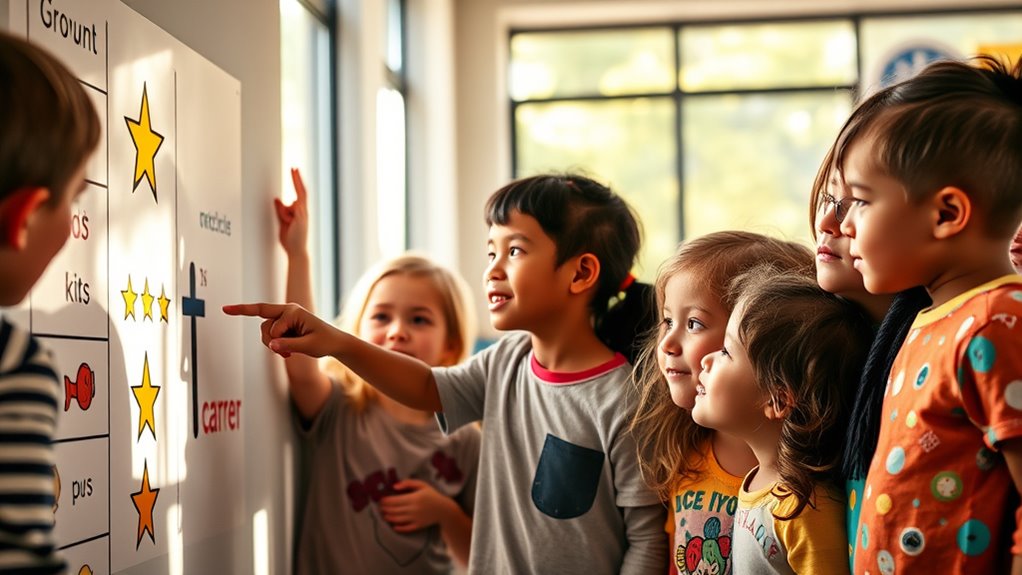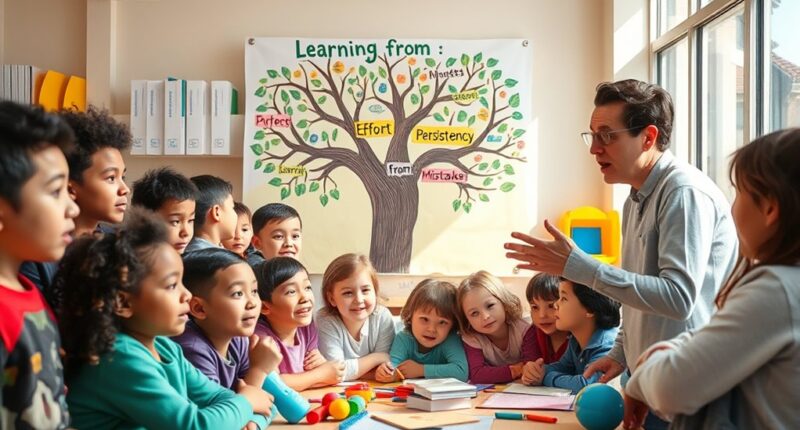The evidence shows that fostering a growth mindset in kids encourages resilience, motivation, and a love of learning by emphasizing effort rather than innate talent. When you praise effort and view mistakes as part of learning, you help your child develop confidence and perseverance. Creating a supportive environment that emphasizes progress and effort can shape positive attitudes toward challenges. Keep exploring how you can support this mindset to help your child thrive academically and emotionally.
Key Takeaways
- Scientific research shows growth mindset promotes resilience, perseverance, and a love of learning in children.
- Parental and teacher praise focusing on effort rather than innate ability fosters a growth mindset.
- Classroom strategies that emphasize process, effort, and progress positively influence children’s motivation.
- Developing a growth mindset creates a culture of resilience, encouraging children to view setbacks as learning opportunities.
- A growth mindset in children is linked to improved confidence, problem-solving skills, and lifelong learning habits.

Have you ever wondered how some kids bounce back from mistakes and keep trying? It’s a question many parents and teachers ask, especially when trying to foster resilience and a love of learning. The answer often lies in the way children develop their mindset—specifically, whether they believe their abilities can grow with effort or are fixed traits. This concept, known as a growth mindset, isn’t just a feel-good idea; research shows it can influence how kids approach challenges, setbacks, and success. As a parent or educator, your influence plays a significant role in shaping this mindset, and the classroom strategies you use can make a real difference.
Parental influence is essential because children look to their caregivers for cues on how to interpret failure and effort. When you praise your child for their hard work rather than their innate talent, you send a message that effort leads to improvement. For example, saying, “You worked really hard on that project,” encourages a growth mindset, whereas saying, “You’re so smart,” might imply that talent is fixed. Your reactions to mistakes matter just as much. When kids see you respond to errors with understanding and encouragement rather than frustration or criticism, they learn that mistakes are part of the learning process, not a sign of failure.
Praise effort over talent to foster resilience and a growth mindset in children.
Classroom strategies also play a fundamental role in cultivating a growth mindset. Teachers who focus on effort and progress, rather than just grades or innate ability, create an environment where kids feel safe to take risks. Techniques like praising the process—such as problem-solving or perseverance—help reinforce the idea that effort matters more than just natural talent. Encouraging kids to set personal goals and reflect on their learning progress fosters a sense of ownership and resilience. Additionally, teaching children about the brain’s ability to grow and change through effort can shift their perspective on challenges, making them more willing to embrace difficult tasks. Understanding that the brain can grow and change through effort reinforces the importance of perseverance.
Ultimately, developing a growth mindset isn’t about instilling a quick fix but creating a culture of perseverance and learning. It starts with you—your words, your reactions, and the strategies you implement. When you model a growth-oriented attitude, you teach children that setbacks are opportunities to learn and that effort is the key to improvement. Whether at home or in the classroom, these small but powerful actions shape how kids perceive their abilities and approach challenges throughout their lives. By fostering this mindset early on, you help them develop resilience, confidence, and a lifelong love of learning.
Frequently Asked Questions
How Can Parents Effectively Foster a Growth Mindset at Home?
You can effectively foster a growth mindset at home by actively engaging in your child’s learning journey. Offer consistent emotional support and praise effort rather than innate ability, encouraging resilience. Be involved in their activities, celebrate progress, and model a growth mindset yourself. Your parental involvement shows that mistakes are opportunities to learn, helping your child develop a positive attitude towards challenges and persistence.
Does a Growth Mindset Improve Academic Performance Significantly?
A growth mindset can improve academic performance, but its effects vary. By leveraging neuroplasticity benefits, you can help your child develop new skills through consistent effort. Motivational techniques like praising effort over talent encourage perseverance, boosting confidence and learning. While a growth mindset isn’t a magic fix, it fosters resilience and a positive attitude toward challenges, ultimately supporting better academic outcomes over time.
Are There Age-Specific Strategies for Teaching Growth Mindset to Children?
You’ll find that age-appropriate, developmental strategies work best when teaching growth mindset to children. For younger kids, use simple language, praise effort, and incorporate play to foster resilience. As kids grow, introduce more complex concepts and encourage reflection on mistakes. Coincidentally, tailoring your approach to their developmental stage helps children internalize the mindset, making it more effective and sustainable across different ages.
Can Growth Mindset Training Benefit Children With Learning Disabilities?
Yes, growth mindset training can benefit children with learning disabilities. You should focus on tailored mindset interventions that address their unique challenges, emphasizing effort and perseverance. By encouraging positive self-talk and resilience, you help these kids see mistakes as opportunities to learn. Your support can boost their motivation and confidence, ultimately improving their academic progress and social-emotional well-being through targeted mindset strategies.
How Long Does It Take to See Changes in Mindset and Results?
You can often start noticing changes in mindset and results within a few weeks to a couple of months. The timeframe expectations vary based on the child’s consistency and the approach used, but patience is key. The mindset development timeline isn’t immediate—regular practice and positive reinforcement help solidify growth. Stay committed, and you’ll likely see gradual improvements in confidence and resilience, reinforcing the benefits over time.
Conclusion
Remember, adopting a growth mindset is like planting a seed that, with patience and effort, can blossom into confidence and resilience. While the evidence shows it’s not a magic wand, fostering this mindset helps kids see challenges as opportunities rather than obstacles. By nurturing their belief that they can grow, you’re fueling a garden of endless potential. With consistent encouragement, you’ll see them bloom into their best selves, ready to face the world’s storms.









